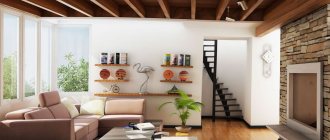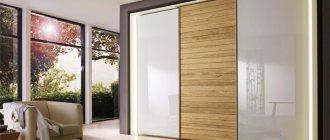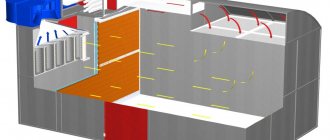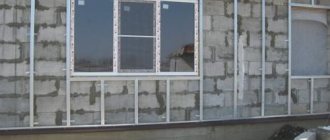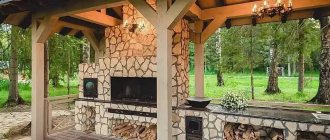The high density of urban development and the insatiable desire to use every square meter for construction are forcing architects and designers to resort to vertical gardening of walls. This allows you to soften the grayness of city streets with the green flowers of climbing plants.
Problems solved by landscaping vertical wall surfaces
Vertical gardens have become part of many innovative design solutions. The planes of walls, fences and fences, located vertically, are a good platform for landscaping houses and plots. Given the lack of space in courtyards, these ideas look not only original, but also a logical solution to bring the greenery of façade walls to the city streets.
Vertical vegetation not only looks like a natural and aesthetic decoration of the facade of the house, but also performs many useful functions. Green plants block some of the sun's ultraviolet radiation. The microclimate in the interior improves, making the air fresher and cooler. The need for conditioning is reduced. This allows you to save up to a third of your air conditioner's energy costs.
Plants lower the temperature of the external walls of buildings, reducing the flow of heat into the rooms. Foliage filters sunlight, creating unusual wall patterns and a playful mood. If deciduous vegetation is used for landscaping, then in summer the rooms will be shaded, and in winter sunlight will freely penetrate into the house.
Vertical gardening of walls enriches the surrounding air space with oxygen, creating more comfortable living conditions. Foliage absorbs sound: studies show that green plants on the facade reduce background noise by up to 50 dB. So street noise and traffic sounds will not interfere with the privacy of the residents of the house.
The exterior of the building may change colors depending on the time of year. This is achieved by using various plants and flowers for landscaping, which, when in bloom, will transform the façade of the building beyond recognition. Flowering plants will attract bees and other insects, which will create a unique atmosphere of unity with nature.
Phytowalls made from living plants
Serious architectural structures, the aesthetic effect of which is comparable only to a work of art.
If there is a phytowall in the interior, then it is the center, the highlight of the entire project. This status requires an appropriate approach. The project of assembling and maintaining a phytowall is a complex job that needs to be entrusted to experienced professionals. The design of a phytowall requires knowledge for proper installation, water supply, and lighting installation. The choice of plants is a separate basic issue. Not all flowers can live in phytowalls permanently and look good at the same time. Consciously choose the place for vertical gardening. Living plants will require high humidity and constant lighting.
Creating a phytowall costs about RUB 40,000 per 1 m² - it all depends on the assortment of plants. Plus there will be regular costs for professional care.
Vertical Gardening of House Walls – what is it?
Vertical gardening is a very fashionable trend in landscape design in the West today. The eternal problem of “grandmother” - Europe - scanty land plots - forces Western gardeners to raise their heads to the sky, looking for free square meters there. And they find it, I tell you, and do this! But it's better to see it once.
Some of them are simply masterpieces of landscape art, and it is almost impossible to reproduce them without special instructions and equipment. But others are quite simple vertical flower beds. Landscape design will only benefit if you use at least one of the elements of vertical gardening when creating it.
In addition to vertical flower beds, it includes:
- The simplest option is plants that climb along the walls of buildings (knotweed, for example);
- Creepers on wallpaper, arches, pergolas;
- Hanging boxes, flowerpots, containers;
- Hedges.
Different methods of vertical gardening and designs for its formation
In order to make a vertical green wall, you need to first think through and install a support on which the climbing plants will be supported. For the designated purposes, you can use different structural elements. The following elements are the most popular.
Pergolas
In their classic form, they consist of four supporting pillars. An open grille rests on top of them. When making such a structure for vertical gardening, preference is usually given to wood. This is a very warm material, it fits well into different stylistic concepts, its texture goes well with the leaves and trunks of climbing plants.
Classic pergola design Source pinterest.com
With the help of a pergola, designers combine different parts of an ornamental garden, decorate the main entrance to the house, disguise unsightly buildings, create shady corners in which a cozy recreation area is then organized. The minimum height of the pergola is 250 cm, the width of the structure must necessarily be greater than the height. Otherwise, the overall decorative element will not look very organic. Plants should be planted only at one support or at two, the rest should remain free. Then the decor used will look easy. Transparency is the main sign of proper design.
Rope pull
It has two supporting elements, they are dug into the ground or concreted, and wire, thread ropes or chains are stretched between the supports. A climbing rose or maiden grapes are planted below under the tension. In a year, one bush grows up to three, three and a half meters, both plants are highly creeping, they can independently attach to any surface (even glass). Over time, the plants grow well and in some places completely cover the support mesh. A very interesting green composition is created, through which the rays of the sun break through. Due to this, it looks very light, airy and elegant. You can see such decorative elements in the Bagatelle Gardens (Paris) and Regent's Park (London).
Mesh stretch for climbing roses Source pinterest.com
Metal grate
This is a type of rope pull. It is used to hide unsightly boundaries of the local area and to separate functional zones. You can mount it directly on a fence, on a sheer wall. Using a metal lattice, you can connect adjacent pergola supports. Lianas are planted along them, which, growing, allow the formation of a continuous green barrier.
Hedge
The basis for its creation is a fence or screen. Climbing vines (ivy and wild grapes) grow along them. As a result, a solid green wall is formed, which helps to hide the area from prying eyes, contain street dust and prevent it from penetrating deep into the local area.
See also: Contacts of companies that specialize in landscape design.
Arch
In landscape design, this element is presented in the form of a ceiling connecting the top points of two supports. It can be made using different materials, created from stone and concrete, brick and wood. Using arches, designers often connect two parts of the garden and form a transition from one zone to another.
The location for installing the arch is selected with special care. It looks beautiful if something spacious or unusual opens behind it (a lake, a pond, a fountain, a lush flowering bush). The height of the arch is determined using the following criteria: a person passing through it should not touch the upper arch with his head, plants twining around the arch should not catch clothes and hair with their shoots.
Several arches framing the path Source yandex.ru
There are techniques that help visually change the perception of the area of a site. If you install several arches at equal distances from each other and border them with a straight path going deep into the local area, the area will visually appear much longer. It is better to plant honeysuckle, morning glory or clematis near the arches. Clematis has large, colorful flowers that bloom from late spring to fall. The plant does not require special care; it does not need to be pruned. It is able to “conquer” any space on the site, but when planting it, you must remember that this clematis will definitely be the king of the garden.
Hanging containers
To create them, containers of different shapes and sizes are used. They are suspended from fastenings using chains or ropes, and filled with soil into which mineral fertilizers have been previously mixed. Plants that can easily tolerate heat and drought and be wind-resistant are selected for planting. Petunias have all of the above qualities.
Hanging containers on an open terrace Source deltaangelgroup.com
Flower containers
They are used where it is not possible to organize ordinary flower beds. Often, open terraces and the front entrance to the house are decorated in this way, mini-compositions are created that complement the flower beds or mixborders, linking the floral design into one coherent whole. This creates migrating landscaping, which helps to change scenery if necessary.
Flower containers used to create vertical gardening create the impression of a dynamic garden. If the owners want to decorate a separate corner of the garden in a special way before guests arrive, they can remove the containers with flowers and hang them over the pergola. This technique helps to quickly decorate the most hopeless corner of the dacha. The pots themselves play a style-forming role. This is a decorative element with which you can easily emphasize the chosen thematic concept or support it by filling in empty spaces.
Beautiful flower containers Source pikabu.ru
Pros of vertical gardening:
- BEAUTIFUL . Living texture for wall decoration, and various color combinations.
- CURRENT . It will allow you to be special, and for public institutions to stand out among competitors and get more profit.
- HEALTHY . Plants absorb toxic gases and clean and cool the air. Have a positive effect on mood.
- GOOD ACOUSTICS . Plant leaves influence the attenuation of sound in a room by absorbing and dispersing it
A vertical flower bed is, in principle, the same containers of various shapes, which when combined form an interesting green or flowering canvas; it could be an ordinary flower bed if it were placed horizontally.
Consequently, these flower beds are created from containers with plants arranged in tiers. They can take the form of a wall, sculpture, screen or pyramid. Today, similar designs are sold in Ukraine, both for the garden and for the home. Yes, yes, a vertical flower bed can be easily installed on the wall in the bedroom, living room or even in the bathroom. And they are called phytopictures (those that are smaller) and phytosthenams (those that are larger).
But I digress from the topic. Today we are talking about vertical flower beds in the garden. These structures can be purchased (the most advanced ones have built-in drip irrigation systems) separately or together with plants, or you can make them yourself. For example, a flowerbed-tower with petunias.
Landscaping of the apartment
Many housewives have window sills full of house plants, which can please the eye of their owner with year-round foliage and flowers.
But you can go further and add greenery to your apartment using a wall of greenery. The easiest way is to use special phytomodules for vertical gardening for this purpose. But you can create a similar wall yourself, using fine mesh and unpretentious plants such as mosses or succulents.
The beautiful and unusual appearance of such a wall will amaze any guest, and the owners of the apartment will receive additional oxygen.
Photos of vertical gardening will help you find the most interesting solutions.
What plants to choose for vertical gardening?
Inventive gardeners have even learned to grow vegetables in vertical flower beds. In this case, of course, they are called not flower beds, but vegetable gardens. Imagine how many vegetables, herbs and herbs can be grown right in your pockets! More precisely, on such special hanging structures with pockets, which are hung on the wall of a house, barn or any other building.
You can sew it yourself or buy a shoe hanger in a store and attach it to a piece of pipe or cornice. The fabric must be water-permeable. If not, you can make small holes to allow excess water to drain through them. There should be a small container located below where the water will drain after watering. This is the case if such a vertical city is located not on a garden fence, but on a balcony, for example. We fill the pockets with compost, then plant seedlings in them. Plants can also be sown with seeds.
The following plants are suitable for vertical flower beds:
- Popular vines (maiden grape, clematis, morning glory, etc.);
- nasturtium;
- petunia;
- ferns;
- asters;
- dahlias;
- majors;
- many other plants.
When choosing them, you need to consider the following factors:
- Small root;
- compatibility;
- Uniform requirements for the level of humidity and the presence of sun.
https://sempochta.com.ua/ – the best selection of seeds and seedlings by mail
What to pay attention to when landscaping?
When vertical gardening there are several important points to consider:
- liana-like plants often destroy building ceilings and other parts of buildings;
- when landscaping balconies and windows, it is better not to create a solid green wall from climbing plants, since in this case less light and air enters the house;
- When vertically gardening, gazebos or pergolas use climbing plants that cling to the support with tendrils and twine around it. Along the way, you can tie up the stems, thus creating a cool zone and covering individual areas;
- the surface for plants that cling to walls using suction cups or roots (maiden grapes, ivy) must be rough. If the wall is smooth and even, you need to install special supports along which the ampels will climb;
A solid green wall blocks neighbors from
Advantages and disadvantages of vertical flower beds
First, about the pros. This:
- Highly decorative and variety of organization options;
- Saving space, which is of great importance for a small yard;
- Ability to move from place to place;
- Minimal care. You don’t even have to water when organizing a drip irrigation system. From time to time – pruning of plants and periodic feeding.
But there is also a fly in the ointment. It is the same as in the case of vertical beds. Namely:
- Without drip irrigation you will have to water very often. Once you missed it in the heat - and that’s it, goodbye, beautiful vertical flower bed;
- The limited volume of soil significantly narrows the range of plants that can be used for vertical flower beds;
- Mandatory feeding. Without it, plants will wither over time;
- Perennial flowers are not very suitable for such flower beds, because in winter the soil in small containers tends to freeze. The solution is either annual plants, or wintering the entire structure with perennials in a suitable room.
Facade landscaping
For such decoration, you can use completely unpretentious climbing plants, for example, ivy or wild grapes. In just a few years, a boring building will turn into an amazing home for a forest elf.
Moreover, the owners do not even have to make much effort to create such an effect - the plants themselves will entwine the walls, clinging to the slightest protrusions.
Artificial landscaping
It is not always possible to provide plants with the necessary conditions. In such cases, artificial landscaping is used. It comes in the following types:
- Made from artificial material.
- Made from preserved plants. They are not alive, but are processed in such a way as to preserve their appearance.
This type of vertical gardening is very popular. It can be used not only in an apartment or house, but also in other places. Artificial flowers are often used in offices, photo studios, cafes, and shopping centers. Their use has its important advantages:
- There is no need for care: moisturizing, lighting, feeding, cutting.
- They can be used wherever needed. For example, such decoration can be used in a room with low lighting.
- The vertical covering protects against noise. It owes this not only to plants, but also to their base - polymer felt.
However, their use is limited by their inherent disadvantages:
- These coatings have their own shelf life, after which they lose their appearance.
- They fade in bright light.
- When very wet they lose their shape.
Cleaning must be carried out strictly according to the rules. Otherwise the surface may be damaged. When choosing to do your own landscaping, you need to consider what materials were used to create it. Fireproof, UV-resistant, and made from environmentally friendly materials are better suited.
Methods of green construction on the site
Over many centuries, a huge variety of options and methods for vertical gardening of adjacent areas, walls and premises have accumulated. Among them, every zealous owner can find a suitable one and implement it with his own hands, creating a beautiful blooming green ensemble and without spending significant financial resources.
Used ready-made structures and homemade devices
In order for vines and climbing crops to grow upward, supports were invented for them, having different shapes and purposes. These structures can be divided into several main groups.
Arches of various types
Arched vertical gardening is a semicircular or straight overlap between two supports. It is made of metal, wood, stone or brick, concrete. Arches are not placed anywhere in the garden, but above the paths, at the entrance to the garden or to a part of it, a separate area. Arches are designed to fit through, so there are special sizing requirements. A person should pass through the support freely, parts of the vines should not touch clothing or block the passage, spacious high arches fill the garden with air and create a romantic atmosphere.
The shape of the arches can be round or triangular, complex in shape. There are massive and openwork options. During construction, the strength should be calculated so that the support can withstand the load and weight of the vine.
Arch is a great option for romantics
An excellent solution would be a cascade of semicircular arches with blooming roses, forming a beautiful and fragrant corridor for walking.
Metal gratings
Forged openwork metal gratings are already a decoration of the garden. They are attached to the walls or between the supports of the pergola, they make up the spans of the fence for the hedge, you can install the trellis separately, assemble a gazebo from several modules, along which grapes or clematis will climb.
Phytomodules are hung on a steel mesh, and additional containers are attached for planting hanging crops for vertical gardening.
The shape of the cells can be either rectangular or any avant-garde shape or with a floral pattern or curls. Using metal paints, you can give the structure the desired shade that is in harmony with other elements of the surrounding landscape or interior.
The lattice is an original decoration of the yard
Popular articles Description of rough hydrangea Hot chocolate
Hanging containers
Hanging flower beds for vertical gardening are traditionally used in combination with floor and wall flower stands. For planting in them, ampelous plants are suitable, for example, pelargonium or petunia, strewn with flowers or lush greenery and hanging down.
If you choose the right flowers and containers for them, you can create a unique interior
Hanging containers look beautiful on the balconies of city apartments, in parks on poles, they are placed on walls and terraces; a great option would be to hang a phytopan on the wall in the form of felt pockets or wooden pallets with containers for soil, or hang flowerpots on the veranda.
This decoration gives the house a special charm
Pergolas
These oldest elements of landscape architecture, supports, come from Italy, where they are very popular and are present on almost every estate. Vertical gardening with the help of a pergola performs several important tasks at once:
- combines different elements in the garden into a single ensemble;
- masks the desired objects and buildings;
- denotes a passage or entrance to a garden area;
- creates a green room or just a shady corner for relaxation;
- decorates the territory, gives it a certain style.
Four support pillars, usually made of wood with a ceiling at the top, with trellises along which vines climb - this is the simplest pergola. The minimum height of the supports is 2.5 m, and the width is 3–3.5 m. Then the design looks proportional. Massive pillars made of timber, stone, metal or brick require installation on a foundation or special supports.
A kind of gazebo with flowers instead of a roof is a great place to relax
Trellis
These lightweight screens or screens made of wood serve as support for climbing annuals and perennials in vertical gardening, and also zone the space and block outbuildings or a private area by the pool from view.
A trellis is a wooden plank 2–3 cm thick, fastened in the form of a lattice with diamond- or square-shaped cells, to which plant shoots cling. Support pillars are dug into the ground and concreted to support the considerable weight of overgrown shrubs or vines. The height of the trellis reaches 7 m.
With the help of a chapalera you can zone the space
